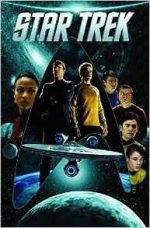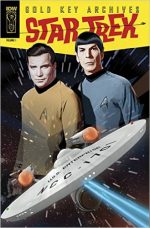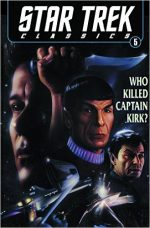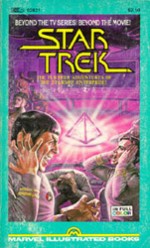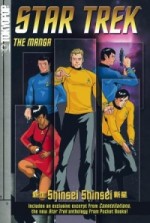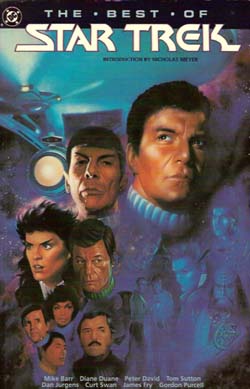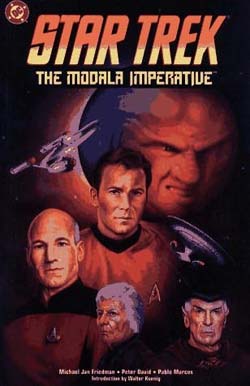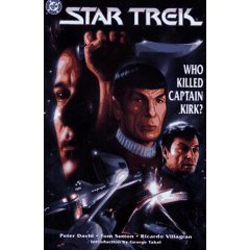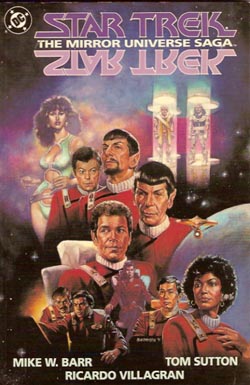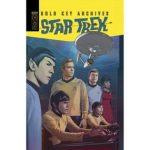
By Dick Wood, Len Wein, Alfredo Giolitti & various (IDW)
ISBN: 978-1-63140-108-4
Star Trek debuted on American televisions on September 8th 1966, running until June 3rd 1969: three seasons comprising 79 episodes. A moderate success, the series only really became popular after going into syndication, running constantly in American local TV regions throughout the 1970s. It was also sold all over the world, popping up seemingly everywhere and developing quite a devoted fanbase.
There was some merchandising, and an inevitable comicbook – from Gold Key – which ran for almost a decade beyond the show’s cancellation. However, at the start neither authenticity nor immediacy were paramount. Only six issues were released during the show’s entire 3-season run: published between July 1967 and December 1968, those quirkily enticing yarns are all gathered in the first Star Trek: Gold Key archive collection.
The reason for the inaccuracies between screen and page was simple and probably a clear indicator of the attitude both studio and publisher held about science fiction material. Scripter Dick Wood (a veteran comics writer with credits ranging from on hundreds of series from Batman to Crime Does Not Pay to Doctor Solar, Man of the Atom) had never seen any episodes when commissioned to write the comic, with he and Italian artists Nevio Zaccara – and later Alberto Giolitti – receiving only the briefest of outlines and scant reference materials from the show’s producers. The comics craftsmen were working almost utterly in a vacuum…
Nevertheless, by the time of these interstellar exploits – reprinting Star Trek #7-12 from March 1970 to November 1971 – the well-intentioned contradictions to now-firmly established Trek lore were slowly fading as better reference and familiarity with the actual show steered the printed Enterprise incidents towards canonical parity with the TV phenomenon.
Following a revelatory Introduction ‘The Adventure Continues…’ from licensed-character specialists/authors Scott and David Tipton, another stunning photo-collage cover – a rarity at the time outside Gold Key titles – leads into an eerie cosmic quest as Kirk and his crew discovers ‘The Voodoo Planet’ (Wood & Giolitti, #7).
In an unexplored region of space, Enterprise discovers an uninhabited doppelganger of Earth, complete with monuments and landmarks. When a hidden mastermind then causes the Eiffel Tower to crumble, word comes that the original back home has also come tumbling down…
As the seemingly magical destruction continues, Enterprise tracks a transmission and travels to a planet almost obscured by debris and space junk and finds there a primitive race practising voodoo…
Shock follows shock as a landing party finds escaped Earth war-criminal Count Dressler has subjugated the natives and adapted their abilities to launch devastating attacks on the world that exiled him…
The villain’s arrogance soon proves his undoing as Dressler underestimates the ingenuity of Mr. Spock and sheer bloody-mindedness of James T. Kirk…
‘The Youth Trap’ was released with a September 1970 cover-date and sees assorted members of the crew transformed into children by a manic alien explorer who has turned a fantastic survival technology into an irresistible weapon.
Whilst Kooba‘s appalled comrades only want to get home, the madman believes his chronal ray will win him a universe. Once again the combination of Spock’s brains and Kirk’s brawn win the day…
From the February 1971 ninth issue, Wood was replaced by dedicated Trek viewer Len Wein (Swamp Thing, Batman, Spider-Man, Hulk) who joined the astounding Alberto Giolitti to explore ‘The Legacy of Lazarus’ wherein the ever outward-bound Enterprise fetched up to a remote planet and found it populated with all the great figures of humanity’s past.
When Spock vanishes his trail leads to a hidden cavern where Earth’s greatest historian Alexander Lazarus has combined robotics and recovered alien technology to gather in the actual brainwaves of history’s giants to create the most astounding resource for knowledge ever conceived.
Sadly, the great feat has only whetted the savant’s appetite and Lazarus wants to perform the same feat with the great and good of Vulcan’s past. To get started, he needs the brain of a native and Spock is the nearest and therefore only logical candidate…
Luckily for the beleaguered Science Officer, Kirk and his comrades can call on the wisdom and courage of Earth’s greatest heroes to aid in their rescue attempt…
With Star Trek #10 (May 1971) stills from Paramount were no longer forthcoming and George Wilson began his series of captivating painted covers. Meanwhile, on the pages inside, mystery and imagination hold sway as the starship is plucked out of the void by a cosmic genie whilst Kirk, Spock, Dr. Leonard McCoy and Chief Engineer Montgomery Scott are dumped at the feet of a storybook tyrant who demands they steal for him the awesome ‘Sceptre of the Sun’…
All too soon however the doughty space-farers unravel the lies underpinning the seeming omnipotence of Chang the Sorcerer to find his true origins stem from a long-lost expedition from Earth in ages past…
From August 1971, ‘The Brain Shockers’ details how neophyte Yeoman Pandora Trask is tricked by a marauding alien into opening a hatch she wasn’t meant to; unleashing a wave of malignant emotions hidden aboard the Enterprise.
The deadly feelings were originally extracted and bottled at the time Vulcans first sought to abandon passion for logic and were being transported to a secret destination, but now their rampage through the ship and the assailant’s world will wreak havoc unless Spock can outthink both them and immortal, seemingly suicidal Malok…
Closing this bombastic treasure-trove is ‘The Flight of the Buccaneer’ (#12, November 1971) with Kirk, McCoy, Scott and Spock ordered undercover to infiltrate a nest of interstellar pirates and recover Star Fleet’s stolen store of Dilithium crystals in a fast-paced, all-guns-blazing romp homaging Treasure Island…
Packed with photo-covers, promotional photos and a complete Cover Gallery this is another fabulously enticing, expansive and epic compendium of thrills: truly engaging stories to delight young and old alike and well worthy of your rapt attentions.
® and © 2014 CBS Studios, Inc. Star Trek and related marks are trademarks of CBS Studios, Inc. All Rights Reserved.

